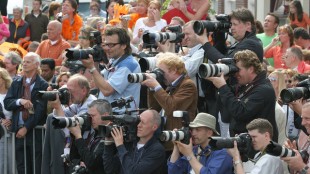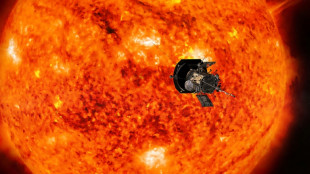-
 Le Pen says days of new French govt numbered
Le Pen says days of new French govt numbered
-
Global stocks mostly rise after US tech rally

-
 Villa boss Emery set for 'very difficult' clash with Newcastle
Villa boss Emery set for 'very difficult' clash with Newcastle
-
Investors swoop in to save German flying taxi startup

-
 How Finnish youth learn to spot disinformation
How Finnish youth learn to spot disinformation
-
South Korean opposition postpones decision to impeach acting president

-
 12 killed in blast at Turkey explosives plant
12 killed in blast at Turkey explosives plant
-
Panama leaders past and present reject Trump's threat of Canal takeover

-
 Hong Kong police issue fresh bounties for activists overseas
Hong Kong police issue fresh bounties for activists overseas
-
Saving the mysterious African manatee at Cameroon hotspot

-
 India consider second spinner for Boxing Day Test
India consider second spinner for Boxing Day Test
-
London wall illuminates Covid's enduring pain at Christmas

-
 Poyet appointed manager at South Korea's Jeonbuk
Poyet appointed manager at South Korea's Jeonbuk
-
South Korea's opposition vows to impeach acting president

-
 The tsunami detection buoys safeguarding lives in Thailand
The tsunami detection buoys safeguarding lives in Thailand
-
Teen Konstas to open for Australia in Boxing Day India Test

-
 Asian stocks mostly up after US tech rally
Asian stocks mostly up after US tech rally
-
US panel could not reach consensus on US-Japan steel deal: Nippon

-
 The real-life violence that inspired South Korea's 'Squid Game'
The real-life violence that inspired South Korea's 'Squid Game'
-
Blogs to Bluesky: social media shifts responses after 2004 tsunami

-
 Tennis power couple de Minaur and Boulter get engaged
Tennis power couple de Minaur and Boulter get engaged
-
Supermaxi yachts eye record in gruelling Sydney-Hobart race

-
 Hawaii's Kilauea volcano erupts, spewing columns of lava
Hawaii's Kilauea volcano erupts, spewing columns of lava
-
Canadian Government Provides C$100 Million Financing LOI to Green Technology Metals in Support of Electric Royalties' Flagship Lithium Royalty Asset in Ontario

-
 Sendero Resources Announces First Tranche Closing of Its Non-Brokered Private Placement
Sendero Resources Announces First Tranche Closing of Its Non-Brokered Private Placement
-
EVSX Completes Installation of Multi Chemistry Line

-
 InterContinental Hotels Group PLC Announces Transaction in Own Shares - December 24
InterContinental Hotels Group PLC Announces Transaction in Own Shares - December 24
-
El Salvador Congress votes to end ban on metal mining

-
 Five things to know about Panama Canal, in Trump's sights
Five things to know about Panama Canal, in Trump's sights
-
NBA fines Minnesota guard Edwards $75,000 for outburst

-
 Haitians massacred for practicing voodoo were abducted, hacked to death: UN
Haitians massacred for practicing voodoo were abducted, hacked to death: UN
-
Inter beat Como to keep in touch with leaders Atalanta

-
 Mixed day for global stocks as market hopes for 'Santa Claus rally'
Mixed day for global stocks as market hopes for 'Santa Claus rally'
-
Man Utd boss Amorim questions 'choices' of Rashford's entourage

-
 Trump's TikTok love raises stakes in battle over app's fate
Trump's TikTok love raises stakes in battle over app's fate
-
Is he serious? Trump stirs unease with Panama, Greenland ploys

-
 England captain Stokes to miss three months with torn hamstring
England captain Stokes to miss three months with torn hamstring
-
Support grows for Blake Lively over smear campaign claim

-
 Canada records 50,000 opioid overdose deaths since 2016
Canada records 50,000 opioid overdose deaths since 2016
-
Jordanian, Qatari envoys hold talks with Syria's new leader

-
 France's second woman premier makes surprise frontline return
France's second woman premier makes surprise frontline return
-
France's Macron announces fourth government of the year

-
 Netanyahu tells Israel parliament 'some progress' on Gaza hostage deal
Netanyahu tells Israel parliament 'some progress' on Gaza hostage deal
-
Guatemalan authorities recover minors taken by sect members

-
 Germany's far-right AfD holds march after Christmas market attack
Germany's far-right AfD holds march after Christmas market attack
-
European, US markets wobble awaiting Santa rally

-
 Serie A basement club Monza fire coach Nesta
Serie A basement club Monza fire coach Nesta
-
Mozambique top court confirms ruling party disputed win

-
 Biden commutes almost all federal death sentences
Biden commutes almost all federal death sentences
-
Syrian medics say were coerced into false chemical attack testimony

Excitement builds as Biden to release first image from Webb telescope
US President Joe Biden will Monday release one of the first images taken by the James Webb Space Telescope, the most powerful observatory ever sent into orbit and a leap forward in uncovering the secrets of the distant universe.
The unveiling will take place at 5:00 pm (2100 GMT) during a livestreamed event at the White House, official statements said, leaving the space community in a state of keen anticipation.
NASA revealed last week Webb's first targets included distant galaxies, bright nebulae and a faraway giant gas planet.
The very first image, released by the US president, will be of the "deep field" -- an image taken with very long exposure time, to detect the faintest of objects in the distance -- according to a person familiar with the matter.
NASA previously said Webb would achieve this shot by pointing its primary imager towards massive foreground galaxy clusters called SMACS 0723, which bend the light of objects far behind them towards the observer, an effect called "gravitational lensing."
This promises to be what NASA chief Bill Nelson called last month the "deepest image of our Universe that has ever been taken."
The rest of the first wave of images are set to be released by NASA on Tuesday.
Webb's infrared capabilities are what make it uniquely powerful, allowing it to both pierce through cosmic dust clouds and detect light from the earliest stars, which has been stretched into infrared wavelengths as the universe expanded.
This lets it peer further back in time than any previous telescope, to the period shortly after the Big Bang, 13.8 billion years ago.
"When I first saw the images... I suddenly learned three things about the Universe that I didn't know before," Dan Coe, a Space Telescope Science Institute (STSI) astronomer and expert on the early Universe, told AFP. "It's totally blown my mind."
- First targets -
An international committee decided the first wave of images would include the Carina Nebula, an enormous cloud of dust and gas 7,600 light years away.
Carina Nebula is famous for its towering pillars that include "Mystic Mountain," a three-light-year-tall cosmic pinnacle captured in an iconic image by the Hubble Space Telescope, until now humanity's premier space observatory.
Webb has also carried out a spectroscopy -- an analysis of light that reveals detailed information -- on a faraway gas giant called WASP-96 b, which was discovered in 2014.
Nearly 1,150 light-years from Earth, WASP-96 b is about half the mass of Jupiter and zips around its star in just 3.4 days.
Nestor Espinoza, an STSI astronomer, told AFP that previous exoplanet spectroscopies carried out using existing instruments were very limited compared to what Webb could do.
"It's like being in a room that is very dark and you only have a little pinhole you can look through," he said of the prior technology. Now, with Webb, "You've opened a huge window, you can see all the little details."
- Million miles from Earth -
Launched in December 2021 from French Guiana on an Ariane 5 rocket, Webb is orbiting the Sun at a distance of a million miles (1.6 million kilometers) from Earth, in a region of space called the second Lagrange point.
Here, it remains in a fixed position relative to the Earth and Sun, with minimal fuel required for course corrections.
A wonder of engineering, the total project cost is estimated at $10 billion, making it one of the most expensive scientific platforms ever built, comparable to the Large Hadron Collider at CERN.
Webb's primary mirror is over 21 feet (6.5 meters) wide and is made up of 18 gold-coated mirror segments. Like a camera held in one's hand, the structure must remain as stable as possible to achieve the best shots.
Charlie Atkinson, chief engineer on the James Webb Space Telescope program at lead contractor Northrop Grumman, told AFP that it wobbles no more than 17 millionths of a millimeter.
After the first images, astronomers around the globe will get shares of time on the telescope, with projects selected competitively through a process in which applicants and selectors don't know each others' identities, to minimize bias.
Thanks to an efficient launch, NASA estimates Webb has enough propellant for a 20-year life, as it works in concert with the Hubble and Spitzer space telescopes to answer fundamental questions about the cosmos.
M.A.Colin--AMWN

